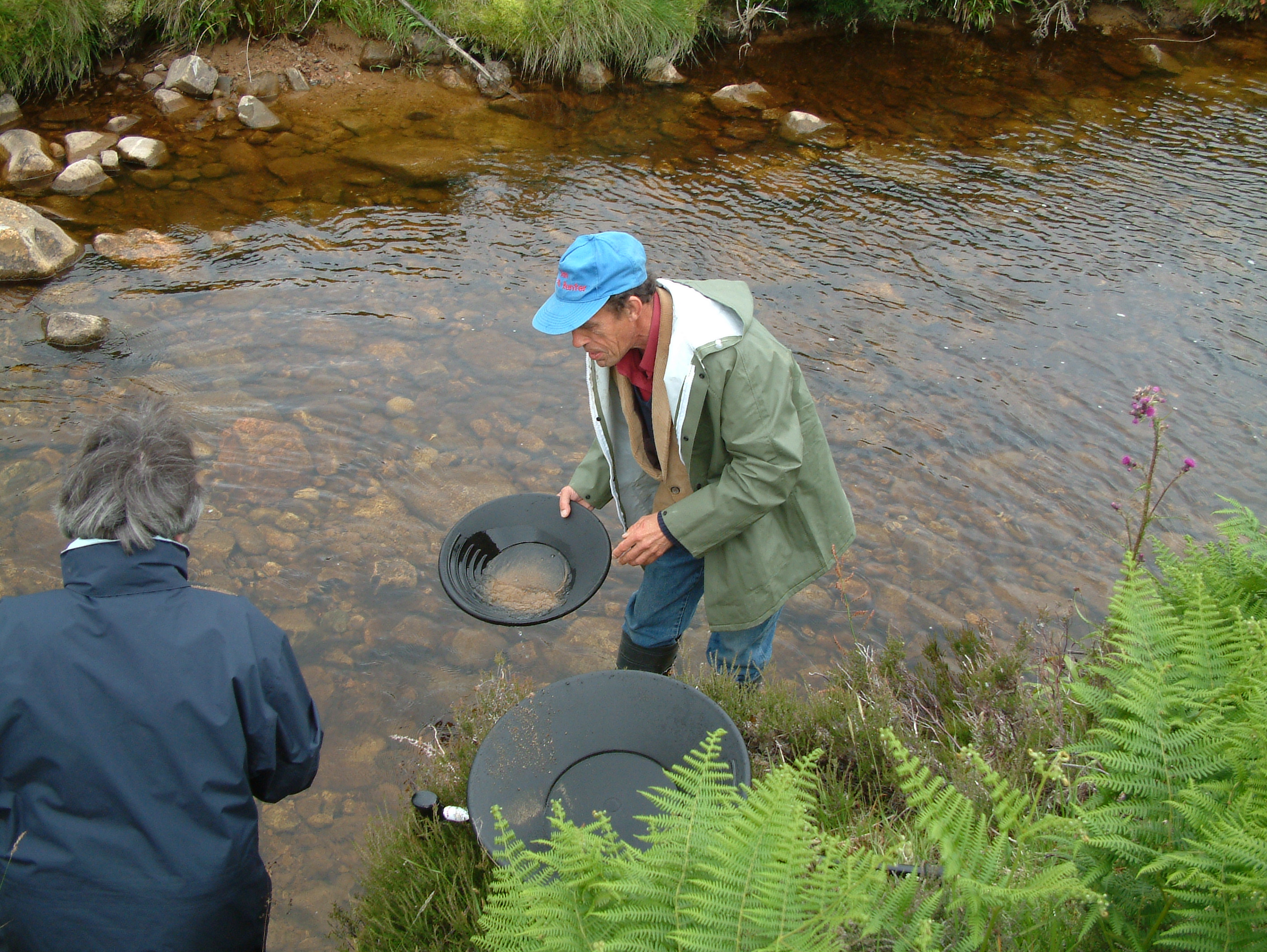Baile an Or is ideal for families and children. It is set in beautiful scenery and you can pan for gold here. There is actually quite a lot of gold, although they are tiny grains. However, some people have collected enough gold to make a wedding ring and other jewellery.
DIRECTIONS
♦ From the south of Helmsdale, cross over the bridge there and then immediately turn left and follow the road until you reach a small roundabout. Take the right turn (northwest) and follow this road all the way down through the housing estate and the road will change to single track. Follow this narrow winding road all the way, always keeping to the north side of the river.
♦ You will eventually come to a sharp bend (left) with a signpost in the grassland ahead and an old bridge, also to the left, where the road winds round across a stream. There is a small car parking area on the bend (the flat grass area) and on the other side, near the sign. You can gold pan anywhere from after the bridge northwards to the waterfall.
♦ Ref: 58.16817°N, 3.85077°W
PROFILE INFO
FIND FREQUENCY: ♦♦♦ – Most people who use the correct panning technique come away with at least a few flakes or granules of gold. Sometimes small nuggets can be found.
CHILDREN: ♦♦♦ – This can be a fun day out for all the family. Note that this location may not be suitable for small children, since the river can be deep in places. Keep an eye on children at all times.
ACCESS: ♦♦♦♦ – Baile an Or is easy to find and parking is next to the river.
TYPE: – Gold panning is done in the stream, so wellington boots are essential.
GOLD PANNING
Panning for gold is only allowed in the stream at Baile an Or between the bridge and the waterfall. There are also limitations on the number of times you can visit in any one year. You need to sign a paper and put it into the box at the notice board. There are full details of these requirements set out on this.
The technique for gold panning involves a lot of patience, but is easy to pick up after the first few attempts. When panning for gold, not everyone is luckily enough to come away with flakes of gold and nuggets are extremely rare. You are more likely to find small flakes. However, Baile an Or makes for an ideal day out for all the family, whether or not you are lucky enough to find gold.

When gold panning, you should place a mixture of dirt and gravel sediment into the pan, which should be about half full. This gravel is best collected from the banks of the river, where the sediment is finest. You will first need to remove any larger objects (twigs for instance) and then gently let the river fill your pan with water.
Start to pull the pan backwards and forwards near the surface of the water, shaking it and tapping it against the heel of your other hand, tilting the pan furthest from you, ensuring that the pan is held so that the ridges are facing away from you. Pull and slightly lift the pan towards you at a slight angle and let some sediment spill over the edge. This is a slow and gradual process, so you should try to avoid losing too much sediment in one go. Repeat this process until you have almost no gravel in the pan and swirl it carefully round in a circular pattern. Any gold should sink to the bottom of the pan, while all other sediment separates to the sides.
GEOLOGY
Gold flakes can be found at this location in the burn.
The gravels and sediments of the Kildonan Burn are salted with small concentrations of gold in the form of tiny granular flecks, and the very occasional little nuggets sometimes combined with quartz.
Visitors are invited to try their hand and spend an enjoyable day in the countryside panning for gold at Baile-An-Or. This is offered free of charge by kind permission of the owners of Suisgill Estate.
The bedrock geology comprises the Kildonan Psammite Formation; psammite and micaceous psammite displayed in metamorphic bedrocks of approximately 542 to 1000 million years ago.


SAFETY
The only real danger is that, in places, the river can be deep. Therefore, keep an eye on children at all times.
EQUIPMENT
To start with, you will need gold pans. However, there is more needed, but all the necessary equipment can be purchased through UK Fossils using our sister site, UKGE.
ACCESS RIGHTS
 Scotland’s fossil resource is at risk of abuse and damage, and so we must all safeguard and managed fossil collecting to ensure its survival for future generations. For this reason it is VITAL you read and adhere to the Scottish Fossil Code for ALL sites in Scotland.
Scotland’s fossil resource is at risk of abuse and damage, and so we must all safeguard and managed fossil collecting to ensure its survival for future generations. For this reason it is VITAL you read and adhere to the Scottish Fossil Code for ALL sites in Scotland.
It is important to follow our ‘Code of Conduct’ when collecting fossils or visiting any site. Please also read our ‘Terms and Conditions‘
LINKS
♦ Buy Fossils, Crystals, Tools
♦ Location Discussions
♦ Deposits Magazine
♦ Join Fossil Hunts
♦ UK Fossils Network








